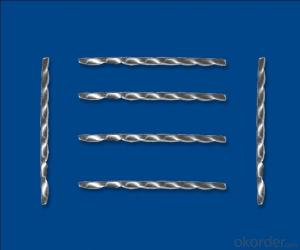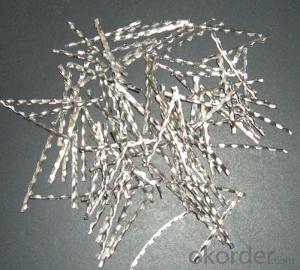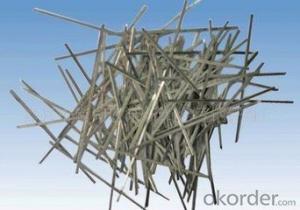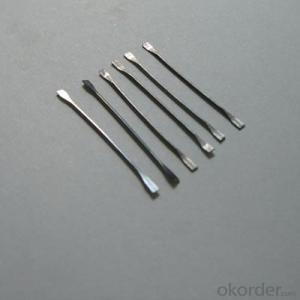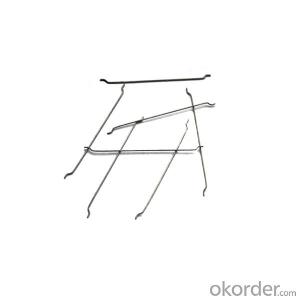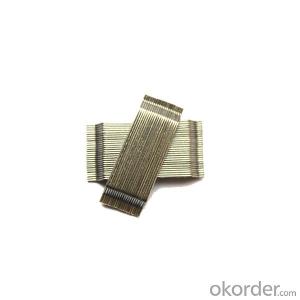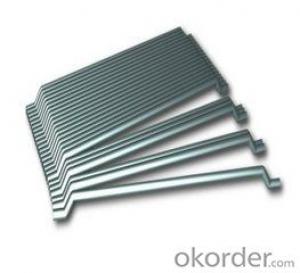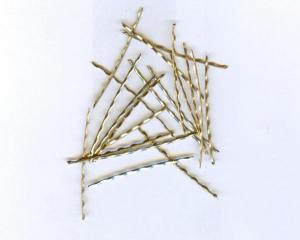Steel Fiber popular wholesale for Industrial Floor Minimum Tenslile Strength
- Loading Port:
- Tianjin
- Payment Terms:
- TT OR LC
- Min Order Qty:
- 5 kg
- Supply Capability:
- 250000 kg/month
OKorder Service Pledge
OKorder Financial Service
You Might Also Like
Quick Details
Dimensions: steel wire
Grade: steel wire
Application: for concrete reinorcement
Shape: clear and bright
material: steel wire
type: wavy steel fiber
shape: corrugated flat fiber
usage: concrete reinforcement
appearance: clear and bright
Place of Origin: Shandong, China (Mainland)
Product features
steel fiber are for concrete construction, greatly improves concrete bonding and tensile strength .
Industrial floor
Precast elements
Tunnel bridge
Highway pavement
Airport pavement
The mining industry
Residential application
Concrete reinforcement
Corrosion protection
Military engine
Specifications
1: Goods: low carbon steel fiber
2: Brand: Jinzhuwang steel fiber
3:Process: Cold drawn
4:Certificate: CE, ISO9001
5:Specification is as follows
Item | Diameter (mm) | Length (mm) | Aspect Radio (L/D) | Tensile Strength (MPa) |
G50/ 25BN | 0.5 | 25 | 50 | ≥1100 |
G60/ 30BN | 0.5 | 30 | 60 | ≥1100 |
G70/ 35BN | 0.5 | 35 | 70 | ≥1100 |
G70/ 35BN | 0.6 | 25 | 42 | ≥1100 |
G50/ 30BN | 0.6 | 30 | 50 | ≥1100 |
G58/ 35BN | 0.6 | 35 | 58 | ≥1100 |
G40/ 30BN | 0.75 | 30 | 40 | ≥1100 |
G47/ 35BN | 0.75 | 35 | 47 | ≥1100 |
G80/ 60BN | 0.75 | 60 | 80 | ≥1100 |
G38/ 30BN | 0.8 | 30 | 38 | ≥1100 |
G44/ 35BN | 0.8 | 35 | 44 | ≥1100 |
G75/ 60BN | 0.8 | 60 | 75 | ≥1100 |
G56/ 50BN | 0.9 | 50 | 56 | ≥1100 |
G67/ 60BN | 0.9 | 60 | 67 | ≥1100 |
G50/ 50BN | 1.0 | 50 | 50 | ≥1100 |
G60/ 60BN | 1.0 | 60 | 60 | ≥1100 |
Picture
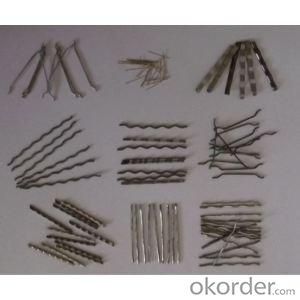
steel fiber concrete reinforced
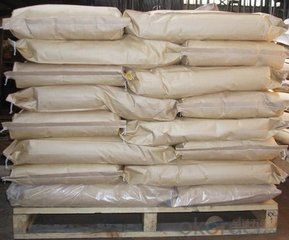
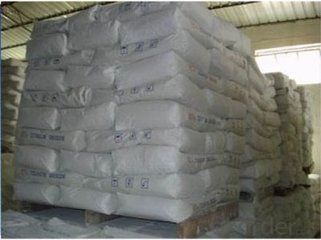

FAQ
we can produce any type steel fiber and of course we can make production according to your requirement
we have specilize in this field for almost 10 years ,with good quality and competitive price
a:Long durability
b:Once the project completed, the rate of crash will be declined a lot, a lot.
c:Economically effective
d:Steel fiber are proven the most effective and economical methods of building diverse concrete buidings
e:Extremely short project time
- Q:Can melt extract stainless steel fiber be used in marine structures?
- Certainly, melt extract stainless steel fiber is applicable for utilization in marine structures. Stainless steel possesses exceptional resistance to corrosion, rendering it a suitable material for deployment in marine settings where exposure to saltwater and high humidity is prevalent. The incorporation of melt extract stainless steel fibers can enhance the reinforcement of concrete or other construction materials employed in marine structures, thereby delivering augmented strength and durability. These fibers exhibit resistance to rust and possess the capability to withstand the harsh conditions commonly encountered in marine environments, thus making them an exceptional selection for marine structures such as piers, docks, and offshore platforms. Moreover, the utilization of stainless steel fibers can contribute to the overall performance and lifespan enhancement of these structures, thereby diminishing long-term maintenance and repair expenses.
- Q:Does melt extract stainless steel fiber improve the resistance to carbonation in shotcrete?
- Yes, melt extract stainless steel fiber does improve the resistance to carbonation in shotcrete.
- Q:Can melt extract stainless steel fiber be used in the construction of water treatment facilities?
- Melt extract stainless steel fiber has the ability to be utilized in the development of water treatment facilities. The durability, strength, and high corrosion resistance associated with stainless steel fibers make them appropriate for a variety of applications within water treatment facilities. These fibers can be incorporated into concrete structures to bolster their mechanical properties and resistance to cracking, which is particularly important in the construction of water treatment plants that commonly encounter water and chemical exposure. The use of stainless steel fibers can also aid in the prevention of crack formation caused by shrinkage and thermal stresses, thereby guaranteeing the long-term integrity and performance of the facility. Furthermore, the application of stainless steel fibers can enhance the overall structural performance and provide superior resistance to abrasion and erosion resulting from the movement of water and particles during the treatment processes. Consequently, melt extract stainless steel fiber represents a valuable material for the construction of water treatment facilities.
- Q:Can melt extract stainless steel fiber reduce the risk of spalling in high-strength concrete?
- Yes, melt extract stainless steel fiber can help reduce the risk of spalling in high-strength concrete. Spalling is a common issue in high-strength concrete, especially when it is subjected to high temperatures or fire. The use of stainless steel fibers can improve the ability of the concrete to withstand such thermal stresses and prevent spalling. Stainless steel fibers are known for their excellent mechanical properties, including high tensile strength and resistance to corrosion. When added to high-strength concrete, these fibers help to reinforce the matrix and enhance its overall durability. They act as a reinforcement, distributing the load more evenly and reducing the risk of cracking and spalling. The unique characteristics of melt extract stainless steel fibers make them particularly effective in preventing spalling. These fibers are usually very fine, with diameters ranging from 0.1 to 0.3 mm. This allows them to be easily dispersed and evenly distributed throughout the concrete mixture, ensuring that they can effectively reinforce the entire structure. Additionally, stainless steel fibers have a high melting point and excellent thermal conductivity. When exposed to high temperatures, the fibers can help dissipate heat and reduce the thermal gradients within the concrete. This prevents the formation of internal stresses, which can lead to spalling. Overall, the addition of melt extract stainless steel fiber to high-strength concrete can significantly reduce the risk of spalling. The fibers reinforce the matrix, improve its resistance to cracking, and enhance its ability to withstand thermal stresses. By preventing spalling, the structural integrity and longevity of the concrete are improved, making it a safer and more durable material.
- Q:How does melt extract stainless steel fiber affect the impact resistance of shotcrete?
- Melt extract stainless steel fiber improves the impact resistance of shotcrete by increasing its toughness and durability. The fiber reinforcement enhances the matrix's ability to withstand impact forces, reducing the likelihood of cracking and spalling. This results in shotcrete that can better withstand impact loads and provides enhanced structural integrity.
- Q:How does melt extract stainless steel fiber affect the curing time of concrete?
- Melt extract stainless steel fiber can potentially reduce the curing time of concrete. The addition of these fibers improves the overall strength and durability of the concrete by enhancing its crack resistance and reducing shrinkage. As a result, the concrete cures faster and achieves its desired strength more quickly.
- Q:What is the recommended fiber geometry for melt extract stainless steel fiber in concrete?
- The recommended fiber geometry for melt extract stainless steel fiber in concrete is typically in the form of straight, monofilament fibers. These fibers are usually slender and have a diameter ranging from 0.15 mm to 0.50 mm. The length of the fibers can vary, but it is often recommended to use fibers with lengths between 20 mm to 50 mm for optimal performance in concrete. The use of straight, monofilament fibers offers several advantages in concrete applications. Firstly, these fibers provide excellent bonding with the surrounding concrete matrix, enhancing the overall mechanical properties of the material. Secondly, the straight geometry allows for effective dispersion and distribution of the fibers throughout the concrete, ensuring uniform reinforcement and improved crack control. Additionally, the slender diameter of the fibers allows for easier mixing and placement of the concrete, without significantly affecting the workability of the mixture. It is important to note that the specific fiber geometry may vary depending on the desired performance requirements and the specific application of the concrete. Therefore, it is recommended to consult with manufacturers or experts in the field to determine the most suitable fiber geometry for a particular project.
- Q:How does melt extract stainless steel fiber improve the resistance to fatigue in shotcrete?
- Melt extract stainless steel fiber improves the resistance to fatigue in shotcrete by increasing the structural integrity and durability of the material. The fibers act as reinforcement, enhancing the tensile strength and preventing crack propagation, ultimately reducing the likelihood of fatigue failure.
- Q:How does melt extract stainless steel fiber affect the carbonation resistance of concrete?
- The addition of melt extract stainless steel fiber can greatly improve the resistance of concrete to carbonation. Carbonation is a chemical process in which carbon dioxide from the atmosphere reacts with the calcium hydroxide in concrete, forming calcium carbonate. This process can decrease the alkalinity of the concrete, leading to corrosion of embedded reinforcement and a decrease in the overall durability of the structure. When melt extract stainless steel fiber is incorporated into concrete, it forms a three-dimensional reinforcement network, which enhances both the mechanical properties and durability of the concrete. These stainless steel fibers act as a physical barrier, reducing the entry of carbon dioxide into the concrete matrix. This barrier effect slows down the carbonation process, effectively increasing the concrete's resistance to carbonation. Moreover, the stainless steel fibers also improve the mechanical properties of the concrete, making it more resistant to cracking and spalling. This increased resistance to cracking further reduces the potential for carbon dioxide to penetrate the concrete, as cracks serve as pathways for gas diffusion. Additionally, the stainless steel fibers provide an extra layer of corrosion protection to the embedded reinforcement, helping to mitigate the effects of carbonation. The fibers function as sacrificial anodes, redirecting any potential corrosion initiation sites away from the reinforcement and onto themselves. This sacrificial anode effect prolongs the service life of the concrete structure by reducing the risk of reinforcement corrosion caused by carbonation. In conclusion, the melt extract stainless steel fiber has a positive impact on the carbonation resistance of concrete by acting as a physical barrier, enhancing mechanical properties, and providing additional corrosion protection to the embedded reinforcement. These advantages contribute to increased durability and extended service life of concrete structures in environments prone to carbonation.
- Q:Does melt extract stainless steel fiber have any adverse effects on the workability of concrete?
- Melt extract stainless steel fiber does not negatively impact the workability of concrete. On the contrary, it actually enhances workability and improves overall performance. Typically, stainless steel fibers are added to concrete for reinforcement, enhancing durability, impact resistance, and crack control. The addition of stainless steel fibers improves the flow and workability of concrete, making it easier to handle and place during construction. These fibers reinforce the concrete and evenly distribute applied loads throughout the matrix, reducing the risk of cracking and improving structural integrity. Additionally, stainless steel fibers provide excellent corrosion resistance, ensuring long-term durability, especially in harsh environments or when exposed to chemicals that could degrade the material. Overall, the inclusion of melt extract stainless steel fibers does not hinder concrete's workability. Instead, it enhances performance, making it more durable, crack-resistant, and easier to work with during construction.
1. Manufacturer Overview |
|
|---|---|
| Location | |
| Year Established | |
| Annual Output Value | |
| Main Markets | |
| Company Certifications | |
2. Manufacturer Certificates |
|
|---|---|
| a) Certification Name | |
| Range | |
| Reference | |
| Validity Period | |
3. Manufacturer Capability |
|
|---|---|
| a)Trade Capacity | |
| Nearest Port | |
| Export Percentage | |
| No.of Employees in Trade Department | |
| Language Spoken: | |
| b)Factory Information | |
| Factory Size: | |
| No. of Production Lines | |
| Contract Manufacturing | |
| Product Price Range | |
Send your message to us
Steel Fiber popular wholesale for Industrial Floor Minimum Tenslile Strength
- Loading Port:
- Tianjin
- Payment Terms:
- TT OR LC
- Min Order Qty:
- 5 kg
- Supply Capability:
- 250000 kg/month
OKorder Service Pledge
OKorder Financial Service
Similar products
New products
Hot products
Related keywords
